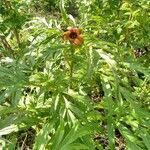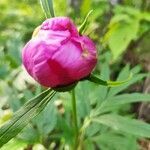Herbs perennial, to 1 m tall. Roots thick, attenuate toward tip, to 50 × 1.5 cm. Stems glabrous. Proximal leaves 2-ternate; leaflets pinnately segmented, base ± decurrent; segments sometimes lobed; segments and lobes linear to linear-lanceolate, 3.5--10 × 0.4--2.1 cm, abaxially usually glabrous, rarely hispid or hirsute along veins and at margin, adaxially hispid or hirsute along veins, apex acuminate. Flowers solitary and terminal, or 2--4 per shoot and both terminal and axillary, single, 7--14 cm wide, sometimes 1--3 underdeveloped flower buds also present in axils of distal leaves. Bracts 2--5, leaflike, unequal. Sepals 3 or 4, ovate-orbicular, 2--2.5 × 1.5--2 cm, apex always or mostly caudate. Petals 6--9, rose to red, very occasionally nearly white, oblong, 3--6.5 × 1.5--3 cm. Filaments 5--10 mm. Disc yellow, annular. Carpels 2--5, sparsely to densely brown-yellow hispid or hirsute, rarely glabrous. Stigma red. Follicles ovoid-ellipsoid, ca. 2--3.1 × 1--1.5 cm. Seeds black, glossy, oblong, ca. 6 × 4 mm. Fl. Apr--Jul, fr. Aug--Sep.
More
A perennial plant. It grows about 50 cm high. It spread to about 50 cm across. The leaves are finely divided. There are fine hairs on the main veins. The leaves are bluish-green underneath. The leaves become orange in autumn. It only has one flower on a stem. The flower is bright red.


